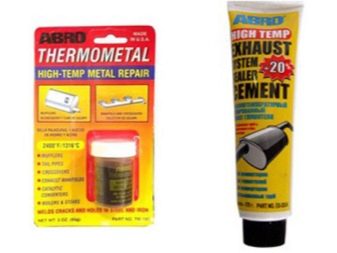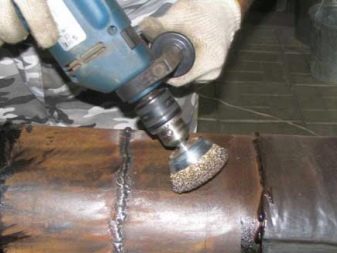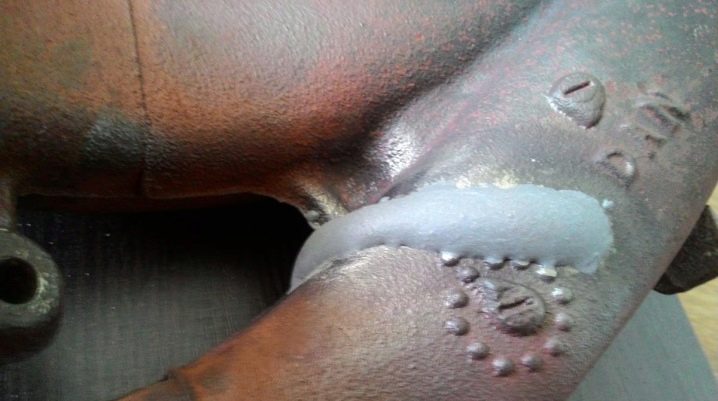Varieties of cold welding for metal

The traditional method of fastening metal elements is welding. However, today there is a worthy alternative, characterized by ease of use and affordability. It is a plastic mass for fixing metal surfaces - cold welding.
Special features
This composition is a plastic adhesive, the consistency of clay. This feature, as well as improved adhesion rates are due to the composition of the mass - it is based on epoxy resin.
As a rule, epoxy resin is located in the center of the cylinder, the outer part of which is hardening agents. High strength seams is achieved by mixing the resin with metal dust. To ensure the composition of these or other technical properties, it adds various components,the most common among which is sulfur. Production processes and material composition comply with GOST 2601-74. When using this composition should be guided by SNiP 3-42-80.
Despite the fact that welding provides high strength and reliable bonding of parts, sooner or later the broken elements must be replaced or restored by a more "serious" method. This composition is very popular for eliminating leaks in plumbing devices (sealing gaps in pipes, repairing threaded connections, etc.), minor repairs, domestic use.
In the best way glue demonstrates its qualities when gluing parts that are not subjected to heavy loads.
The ease of use of this composition lies in the fact that it is suitable for applying both on hollow and filled surfaces, as well as parts that are subject to low pressure. No need to dismantle parts, you can make bonding even in hard to reach places. This method does not involve heating, which means that metal deformation is excluded, as well as a negative effect on neighboring heat sensitive elements.
The work itself does not require professional skills, expenses for the purchase or rental of equipment. Grasping surfaces begins, a few minutes after application, and you can use the repaired part after a day. Due to the variety of compositions, it is possible to pick up the glue for a specific part, including one that is operated in extreme conditions. So, there are such types of cold welding that tolerate high-temperature effects up to 1000 ° C.
Despite the fact that, by its strength, the seam formed by cold welding is inferior to the joint obtained by the method of conventional welding, it is quite durable, one-piece. It is recommended to apply the composition to eliminate minor damages and seal fistulas. Cold welding is combined with all types of metals that are particularly sensitive to heat. It also makes it possible to glue dissimilar metal surfaces. Formed seam looks neat, can be sanded, painted.
This type of compound is based on the principle of pressure, however, a seam is formed due to the plasticity of the adhesive and the ability of its particles to attract material molecules.In other words, plastic deformation takes place, as a result of which the oxide layer on the repaired surfaces is destroyed, and the distance between them becomes similar to the distance in the crystal lattice. At the same time, the energy level of atoms increases, they become capable of forming chemical bonds.
Kinds
Depending on the characteristics of the composition, cold welding is one-component and two-component. The first is not suitable for long-term storage, outdoor glue must be used at one time.
If we talk about the scope of application, then there are the following types of cold welding.
- Universal. Due to the peculiarities of the composition, it is suitable for gluing not only metal, but also plastic, rubber surfaces, including with each other.
- Automotive. Designed to eliminate cracks and minor damage on the metal surfaces of the car, such as tanks, radiators, connecting tubes, etc.
- Providing improved adhesion performance. This property is achieved by adding steel, aluminum or cast iron chips to the resin.Suitable for parts subject to increased loads and pressure, increases the strength and temperature resistance of the seam being formed.
- High temperature. This is a heat-resistant metal-silicate welding of high viscosity, which can be operated at elevated temperatures up to + 1500 ° С. The lower temperature threshold is usually -60 ° C.
- Waterproof. 2-component welding, which does not lose its performance not only in a wet environment, but also in direct contact with water. It is mainly used for the repair of sanitary equipment.
On the basis of the consistency of emit liquid and plasticine compositions. Liquid welding is always a two-component composition consisting of epoxy resin and hardener. Available in syringes, the mixing of the components occurs in the same place automatically. However, experts still recommend mixing the components in a separate container immediately before use.
The plasticine mass is more viscous, it is a one-component or two-component bar. Before use, it is kneaded to obtain a uniform elastic mass.
Glue can also be differentiated into the following groups:
- dot (glue for aluminum and copper coatings, used to eliminate small gaps, welding small parts to larger surfaces);
- suture (designed to eliminate integrity problems in thin-walled sealed vessels and tanks, used in conjunction with contour punches);
- T-shaped (scope of application - fixing brass studs with the findings of transformer windings made of aluminum, T-shaped and angular busbars for electric locomotives);
- butt (suitable for bonding wires, closing the ends, the formation of rings);
- shear welding (used in the repair of water and heating pipes, on the railway - to connect adapters in power lines).
How to use?
The quality of adhesion of glue depends largely on how carefully prepared working basis. It must be cleaned from rust, degreased. For this purpose, special solvents and emery paper are used.
The part covered with a rust should be rubbed with a sandpaper until a layer of a characteristic metallic shade with traces of scratches appears.Smooth surfaces should also be sanded with abrasive paper until scratched. This will improve grip.
The next stage is the drying of surfaces. You can give the base to dry naturally or use a regular hair dryer. Manufacturers note that cold welding may be applied to wet parts, but practice shows that the quality of such compounds is lower. After drying, the surface should be degreased again using, for example, acetone.
After the surface is ready for sizing, it is necessary to cut off the necessary amount of glue from the cylinder. Cut it should be only in the transverse direction, so that the resulting "round" contains both epoxy core and hardener, framing it. If a liquid mixture is used, it is squeezed out of the syringe tube directly onto the surface of the part (as stated in the instructions) or pre-mixed in dishes (as recommended by professionals).
The cut piece must be warmed and made homogeneous, rubbed in the hands. The longer you do this, the softer and more plastic the composition will become.
If he sticks too tight to his hands, you can periodically moisten them with cold water.The work should be carried out in gloves, and the dishes in which the mixture was kneaded or kept should not be used further in the kitchen.
When you feel that the mass adheres well and smears easily, you should immediately apply it to the surface being repaired. If the gap formed is small, then it is desirable that part of the glue penetrates into it. For large gaps, it is better to use “patches”, which are fixed by cold welding.
It is desirable to make the welding layer not more than 5 mm. If necessary, you can apply several layers, waiting for the previous one to dry completely before applying the next one. Most formulations begin to harden within a few minutes after adhesion to the surface. The final freezing occurs after a day. 24 hours after applying the adhesive, you can proceed to the further processing of the repaired surface.
Manufacturers
Leading position in the market is imported products. Domestic counterparts, according to user reviews, do not demonstrate the same high quality and strength of the seam.
The most durable welding, according to professionals, as well as on the basis of expert data, is produced under the brands Hi-Gear, Abro, Poxipol.
- The variant from the first brand is a universal compound suitable for working with metal, as well as stone and plastic surfaces. Demonstrates heat resistance and chemical inertness.
- Abro is two-component welding, also characterized by versatility of use. Maintains heating to 260 ° C, is suitable for operation in chemically aggressive environments.
- Approximate to them in quality domestic analogues - "Polimet", "Almaz".
- For plumbing and heating pipes, it is better to use Mastix products, but only on condition that the heat carrier in these systems has a temperature not exceeding 120 ° C. This makes the composition an excellent option for welding at home, but does not allow it to be used to repair production systems with a higher heating temperature.
- For heat-resistant systems, it is better to choose Kerry Thermo glue, which is characterized by increased viscosity and the ability to withstand heating up to + 900 ° C. This composition has proven itself well when working with cast-iron, steel and titanium bases, it is widely used in car repairs.
- Good quality is demonstrated by Henkel's “Super Epoxy Moment” product for universal use, which withstands heating up to 140 ° C. Similar properties are demonstrated by the composition of Adefal Trading S. A. Poxipol, but the heating temperature when used can reach only 120 ° C.
Tips and tricks
- When choosing cold welding it is necessary to consider the scope of its application. It is better if the metal used in the adhesive is similar in composition to the surface to be repaired. If it is impossible to find such a composition, one should choose welding with a metal core, the strength indices of which are not inferior to those of the surface metal.
- It is important to pay attention to the temperature range of the adhesive. Despite the fact that all its varieties can withstand an increase in temperature (on average up to 200-230 ° C), for surfaces exposed to significant heating or the action of an open flame, you should choose specialized compositions.
- If you need a quick repair, it is desirable to use 2 types of welding. First, a layer of the one that is characterized by an accelerated solidification time (about an hour) is applied. This will quickly eliminate the accident.However, this layer can not be called durable, so another layer of welding with a standard curing time is applied on top of it (it dries 24 hours).
- Remove frozen cold welding is not easy. To do this, use special solvents, if they are not - acetone. They need to moisten the glue thoroughly and try to hook it over the edge of the base. If this can be done, welding is literally stripped from the surface.
This method itself can damage the surface, and if acetone is applied on a base made of wood, glass or ceramic, it can darken them. In this regard, the composition should be applied carefully and carefully, without scattering the prepared and crushed glue on the surfaces adjacent to the workers.
For information on how to use cold welding, see the following video.
























































